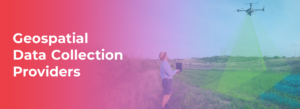Computer Vision Research Report
Researchers have various viewpoints on studying computer vision. Besides capturing raw data, it uses methods and concepts that merge computer graphics, machine learning, pattern recognition, and digital image processing. As a Result, Given its widespread usage, academics are actively integrating it with various fields and disciplines. Looking ahead, We may anticipate new and larger use cases for CV algorithms in 2024, along with an increase in their power and widespread usage.
In every industry, AI is shown to be revolutionary, and computer vision is no different. The ability to create precise data, which can be used to train computer vision systems (such as facial recognition and object detection) more affordably and with a lower risk of violating privacy, is one way that it is likely to influence the development of computer vision technology in 2024. Additionally, it can be used to classify training data far more quickly and effectively than by using expensive and time-consuming human labor to label data by hand.
What is Computer Vision?
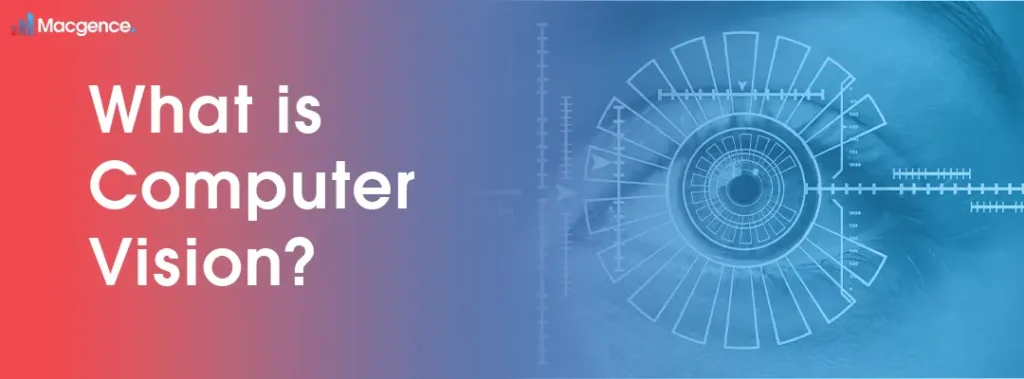
Computer vision, an area of artificial intelligence, allows devices and computers to interpret digital photos, videos, and other visual inputs to extract meaningful information. Consequently, Based on this information, the devices and computers can act or recommend additional actions. In essence, Computer vision allows computers to see, observe, and learn, just as AI allows them to think. It also uses cameras, data, and algorithms to train robots to perform tasks in a fraction of the time.
The goal of computer vision in AI is to create automated systems that can process visual information, like images or videos, in the same way humans do. It teaches machines to understand and interpret images pixel by pixel. This forms the basis of the field of computer vision. In short, computers attempt to extract visual data, organize it, and use advanced software to analyze the results.
How Computer Vision Works?

Computer vision works by enabling machines to interpret and make decisions based on visual data. Here is a simple overview of the process:
1. Image Input
First, the input of visual data, usually in the form of pictures or video frames, is the initial step in computer vision.
2. Preprocessing
Next, raw images are often preprocessed to enhance their quality and reduce noise. This may include tasks like resizing, normalization, and filtering.
3. Feature Extraction
Computer vision algorithms identify relevant features within the images, such as edges, corners, or textures. Feature extraction helps represent the visual content in a more manageable form.
4. Object Recognition
Afterward, the system is trained to recognize specific objects or patterns within the images. This involves using machine learning algorithms to associate features with particular objects or classes.
5. Image Classification
Once objects are recognized, the system can classify them into predefined categories or classes. This step involves assigning labels to the identified objects.
6. Localization
Computer vision systems often provide information about the location of recognized objects within the image. This can include bounding box coordinates or pixel-level segmentation.
7. Object Tracking (in videos)
In addition, in video analysis, computer vision can track objects across frames, allowing for the monitoring of movement and changes over time.
8. Semantic Segmentation
Moreover, in some applications, computer vision performs semantic segmentation to understand the layout of different objects in an image at a pixel level.
9. Decision Making
Then, based on the information gathered through the above steps, the computer vision system makes decisions or takes actions. This could involve generating reports, triggering alerts, or controlling other systems.
10. Feedback Loop (in Machine Learning)
As a result, in cases where the system is built with machine learning, creating a feedback loop is standard procedure. This loop involves ongoing training of the model and refinement through the addition of new data to enhance and optimize the model’s performance over time.
11. Application-Specific Output
Ultimately, the final output depends on the specific application. It could be anything from identifying objects in autonomous vehicles to facial recognition in security systems.
Consequently, industries like manufacturing, augmented reality, autonomous vehicles, and healthcare benefit from the vast applications of computer vision. The strength of algorithms, the caliber of data, and continuous enhancement and training efforts significantly influence the effectiveness of computer vision systems.
Why is it a good idea to invest in computer vision?
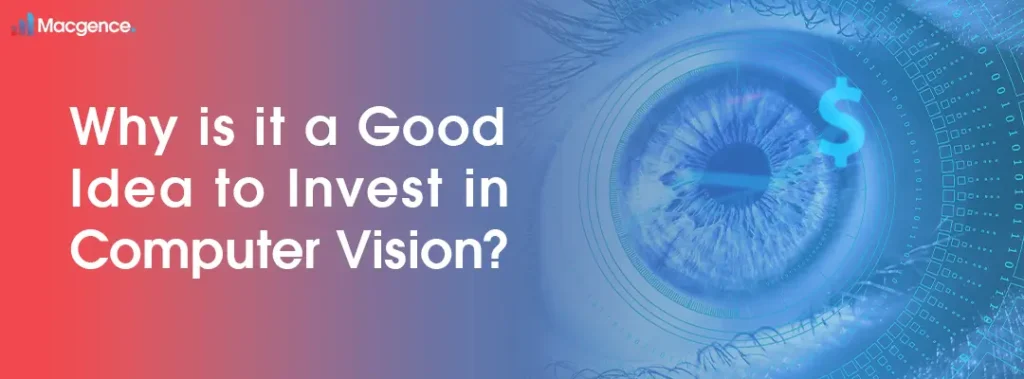
Because computer vision has various uses and can serve many industries, investing in it can have many benefits. Here are a few of the benefits:
1. Enhanced Effectiveness
Automation of several tasks, such as data analysis, object detection, and quality control, is possible by computer vision.
2. Precision Improvement
Refining decision-making processes requires increased precision and accuracy in computer vision systems. As a result, there are fewer errors and overall improvements in operational precision.
3. Efficient Cost Management
Cost savings result from the application of automation and increased efficiency. This is possible by reducing the amount of physical effort used and reducing errors that could otherwise cause financial losses.
4. Better Insights
Computer vision provides insightful information using deep data processing. As a result, this gives companies the ability to identify trends, make well-informed decisions, and gain a thorough understanding of their operations.
5. Competitive Advantage
Moreover, investing wisely in modern technologies like computer vision can provide an advantage over competitors. This, in turn, presents a company as a leader in the sector by offering creative ideas and staying ahead of the curve.
6. Elevated consumer Experience
Computer vision improves consumer experiences in industries such as healthcare and retail by simplifying service delivery, personalizing recommendations, and improving overall interactions.
7. Quality Control
In particular, within manufacturing and production, computer vision systems play a pivotal role in enforcing rigorous quality control standards. This ensures that products meet elevated benchmarks, effectively minimizing defects.
8. Safety and Security
Additionally, applications of computer vision in surveillance and security improve safety measures through real-time monitoring, proactive threat detection, and responsive capabilities, fostering a secure environment.
9. Innovation Potential
Furthermore, committing to computer vision investments paves the way for ongoing innovation. This commitment fosters the development of novel applications and solutions, adept at addressing ever-evolving challenges.
10. Diverse Applications
For example, applications for computer vision are present in areas such as autonomous cars, agriculture, healthcare diagnostics, and more, showcasing the technology’s adaptability and versatility.
11. Data-driven Decision Making
Through the utilization of data derived from visual inputs, computer vision empowers businesses to engage in data-driven decision-making. Thus, this capability enables swift responses to dynamic conditions and market demands.
12. Future-Proofing
Finally, as technology undergoes continuous evolution, an investment in computer vision positions businesses to proactively stay ahead of the curve. In doing so, this approach ensures adaptability to future advancements and emerging market trends.
Investing in computer vision has many advantages, but companies must carefully plan and execute their implementation for better results. Any strategy for investing in computer vision should consider ethical use, data protection, and continuous maintenance.
Computer Vision Algorithms
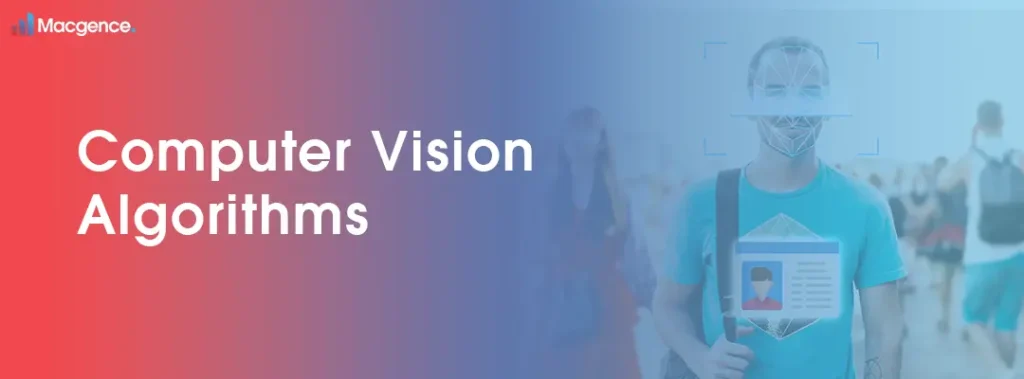
Algorithms for computer vision are mathematical processes created to provide machines the ability to see, interpret, and process visual data, imitating human vision. As a result, these algorithms process digital photos or video frames to carry out specific tasks or derive insightful information. In general, there are several types of computer vision algorithms, each tailored to address different aspects of visual data analysis. Some common types include:
1. Image Classification Algorithms
Label or categorize images by recognizing specific patterns or features. Since convolutional neural networks (CNNs) are very efficient, they are useful in image categorization tasks.
2. Object Detection Algorithms
Locate and identify objects inside pictures or video frames, often using bounding boxes around the objects that are found. The two popular algorithms in this category are R-CNN (Region-based Convolutional Neural Network) and YOLO (You Only Look Once).
3. Semantic Segmentation Algorithms
For instance, semantic segmentation gives each pixel in a picture a semantic name to completely define the object boundaries. FCN (Fully Convolutional Network) and U-Net are two techniques used for this purpose.
4. Feature Detection and Matching Algorithms
Furthermore, feature detection and matching identify key features in images and match them across different frames or images. In particular, common examples include SIFT (Scale-Invariant Feature Transform) and SURF (Speeded Up Robust Features).
5. Object Recognition and Localization Algorithms
Recognize and locate objects within images without specifying the object categories. This involves identifying the object and determining its position. Feature-based algorithms are commonly used for this purpose.
6. Motion Analysis Algorithms
Similarly, motion analysis algorithms are used to analyze the motion patterns within video sequences, including tracking moving objects or detecting changes over time. Optical flow algorithms and background subtraction techniques fall into this category.
7. 3D Computer Vision Algorithms
Moreover, some algorithms take on tasks like depth estimation, interpreting three-dimensional scenes, and reconstructing multiple 2D images. Examples include stereo vision and Structure from Motion (SfM).
8. Face Recognition Algorithms
Likewise, face recognition algorithms identify and authenticate individuals based on facial features. FaceNet and OpenFace are popular algorithms used for this task.
9. Image Generation Algorithms
Additionally, image generation tasks create new images based on learned patterns or styles. For example, Generative Adversarial Networks (GANs) are commonly used.
10. Image Captioning Algorithms
Lastly, image captioning algorithms generate descriptive captions for images by combining image understanding with natural language processing. Show and Tell and Transformer-based models are typically employed for this purpose.
The particular task and the properties of the visual data under analysis determine which algorithm is best. Computer vision algorithms are developed and improved through machine learning, especially deep learning, which enables systems to learn and adapt to visual patterns.
Industry-Wide Use Cases
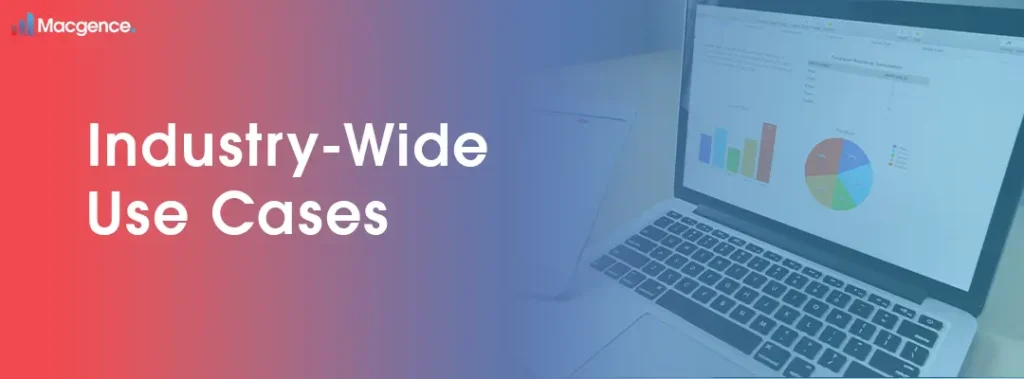
Computer vision is transforming processes and increasing efficiency across various sectors. Here are industry-wide use cases for this technology:
1. Manufacturing
- Quality Control: In manufacturing, computer vision assures product quality by identifying flaws or irregularities in production procedures.
- Process optimization: Moreover, it optimizes production lines by monitoring workflows and spotting areas for improvement.
2. Healthcare
- Medical Imaging: In healthcare, it helps in diagnosis by analyzing medical images like X-rays, MRIs, and CT scans, leading to faster and more accurate assessments.
- Surgical Assistance: Supports surgeons with real-time insights during surgeries via augmented reality.
3. Retail
- Shelf Monitoring: In retail, computer vision keeps an eye on product availability and shelf arrangement for improved inventory control.
- Customer analytics: Additionally, it assesses consumer behavior to develop personalized marketing plans and improve store designs.
4. Automotive
- Autonomous Vehicles: In transportation, computer vision supports autonomous vehicles by sensing and reacting to their surroundings, ensuring safety and navigation.
- Quality inspection: helps to assure the quality of automobile parts during production.
5. Agriculture
- Crop monitoring: In agriculture, drones use computer vision to track crop health, detect illnesses, and adjust irrigation.
- Harvesting Automation: Furthermore, it identifies and selects ripe crops automatically as part of the harvesting process.
6. Finance
- Fraud Detection: In finance, computer vision increases security by detecting irregularities in bank transactions.
- Document Verification: Moreover, it verifies and processes documents efficiently in banking and financial institutions.
7. Security and Surveillance
- Facial Recognition: In public safety, computer vision identifies and tracks individuals for enhanced safety in public spaces.
- Intruder Detection: Additionally, it notifies security staff of any unlawful access or suspicious behavior.
8. Education
- Automated Grading: In education, computer vision helps trainers by automating evaluation and assignment grading.
- Interactive Learning: Furthermore, it enhances augmented and virtual reality experiences for more immersive learning.
9. Construction
- Project Monitoring: In construction, computer vision monitors sites for safety compliance, progress tracking, and issue identification.
- Blueprint Analysis: Moreover, it analyzes architectural plans for precise project execution.
10. Energy
- Predictive Maintenance: In energy, computer vision tracks equipment conditions to foresee and prevent malfunctions.
- Environmental Monitoring: Additionally, it monitors and regulates the environmental impact of energy production.
11. Logistics and Transportation
- Package Sorting: In logistics, computer vision automates sorting processes in logistics centers, improving efficiency.
- Traffic Management: Additionally, it enhances traffic flow and safety through real-time monitoring and analysis.
12. Entertainment
- Virtual Reality: In entertainment, computer vision offers realistic gaming and immersive experiences through gesture detection and object tracking.
- Content Creation: Moreover, it assists in video editing and special effects through automated visual analysis.
In conclusion, these use cases illustrate how adaptable and revolutionary computer vision technology is, influencing industries from consumer experiences and safety to operational efficiency.
Get Started with Computer vision with Macgence
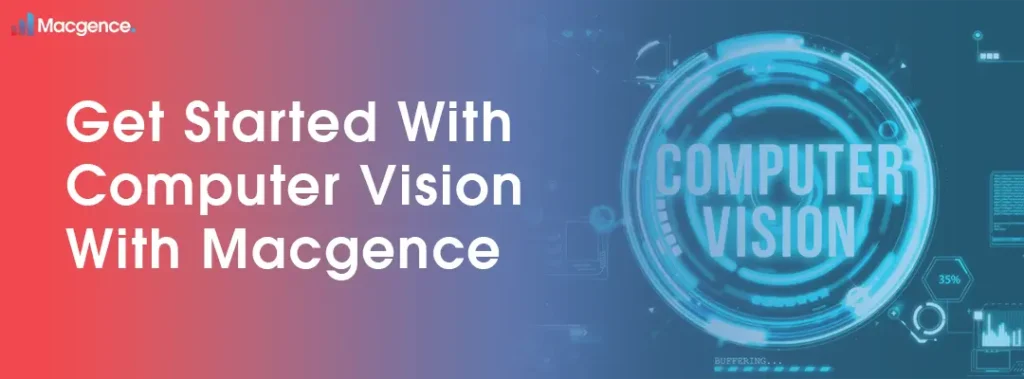
Computer vision technology is experiencing widespread adoption among businesses aiming to enhance visual data processing. As a renowned provider, Macgence assists customers in the realm of computer vision by:
1. First and foremost, aligning computer vision solutions with specific business objectives, ensuring a seamless fit with company goals.
2. Furthermore, developing and training AI models using historical visual data to refine and optimize computer vision solutions, allowing for continuous improvements.
3. In addition, crafting personalized visual interactions and establishing a distinct visual identity to differentiate your brand in the marketplace.
4. Moreover, integrating computer vision technology seamlessly into existing business software, providing ease of use and functionality.
5. Finally, assessing impact and fine-tuning computer vision platforms for optimal performance, ensuring long-term success.
As a result, partnering with Macgence gives you the confidence to adopt transformative computer vision technologies. Contact us to offer your customers a responsive and tailored computer vision experience.
You Might Like
February 28, 2025
Project EKA – Driving the Future of AI in India
Artificial Intelligence (AI) has long been heralded as the driving force behind global technological revolutions. But what happens when AI isn’t tailored to the needs of its diverse users? Project EKA is answering that question in India. This groundbreaking initiative aims to redefine the AI landscape, bridging the gap between India’s cultural, linguistic, and socio-economic […]
April 5, 2025
The Ultimate Guide to Geospatial Data Collection Providers
Geospatial data collection has become an essential part of modern industries, playing a vital role in urban planning, environmental monitoring, transportation, agriculture, and defense. With the advent of advanced technologies such as artificial intelligence (AI), satellite imaging, drones, and LiDAR, the geospatial industry is witnessing a rapid transformation. In this blog, we will explore some […]
April 1, 2025
The Strategic Benefits of Partnering with Macgence for Model Evaluation and Validation
In the rapidly evolving AI landscape, ensuring robust model performance is not just an advantage—it’s a necessity. For businesses leveraging AI/ML technologies, partnering with a specialized validation partner like Macgence can mean the difference between unreliable prototypes and enterprise-grade AI solutions. At Macgence, we bring unmatched expertise in AI model evaluation and validation to help […]
March 24, 2025
Natural Language Generation (NLG): The Future of AI-Powered Text
The ability to generate human-like text from data is not just a sci-fi dream—it’s the backbone of many tools we use today, from chatbots to automated reporting systems. This revolution in artificial intelligence has a name: Natural Language Generation (NLG). If you’re an AI enthusiast or a tech professional, understanding NLG is essential for keeping […]


 Previous Blog
Previous Blog





